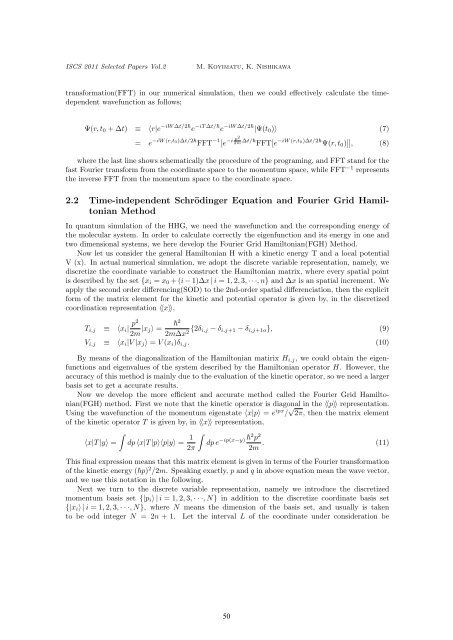RECENT DEVELOPMENT IN COMPUTATIONAL SCIENCE
RECENT DEVELOPMENT IN COMPUTATIONAL SCIENCE
RECENT DEVELOPMENT IN COMPUTATIONAL SCIENCE
Create successful ePaper yourself
Turn your PDF publications into a flip-book with our unique Google optimized e-Paper software.
ISCS 2011 Selected Papers Vol.2 M. Koyimatu, K. Nishikawa<br />
transformation(FFT) in our numerical simulation, then we could effectively calculate the timedependent<br />
wavefunction as follows;<br />
Ψ(r, t0 + ∆t) ≡ 〈r|e −iW ∆t/2� e −iT ∆t/� e −iW ∆t/2� |Ψ(t0)〉 (7)<br />
= e −iW (r,t0)∆t/2� FFT −1 p2<br />
−i<br />
[e 2m ∆t/� FFT[e −iW (r,t0)∆t/2� Ψ(r, t0)]], (8)<br />
where the last line shows schematically the procedure of the programing, and FFT stand for the<br />
fast Fourier transform from the coordinate space to the momentum space, while FFT −1 represents<br />
the inverse FFT from the momentum space to the coordinate space.<br />
2.2 Time-independent Schrödinger Equation and Fourier Grid Hamiltonian<br />
Method<br />
In quantum simulation of the HHG, we need the wavefunction and the corresponding energy of<br />
the molecular system. In order to calculate correctly the eigenfunction and its energy in one and<br />
two dimensional systems, we here develop the Fourier Grid Hamiltonian(FGH) Method.<br />
Now let us consider the general Hamiltonian H with a kinetic energy T and a local potential<br />
V (x). In actual numerical simulation, we adopt the discrete variable representation, namely, we<br />
discretize the coordinate variable to construct the Hamiltonian matrix, where every spatial point<br />
is described by the set {xi = x0 + (i − 1)∆x | i = 1, 2, 3, · · ·, n} and ∆x is an spatial increment. We<br />
apply the second order differencing(SOD) to the 2nd-order spatial differenciation, then the explicit<br />
form of the matrix element for the kinetic and potential operator is given by, in the discretized<br />
coordination representation 〈〈x〉〉,<br />
Ti,j ≡ 〈xi| p2<br />
2m |xj〉 =<br />
�2<br />
2m∆x2 {2δi,j − δi,j+1 − δi,j+1a}, (9)<br />
Vi,j ≡ 〈xi|V |xj〉 = V (xi)δi,j. (10)<br />
By means of the diagonalization of the Hamiltonian matirix Hi,j, we could obtain the eigenfunctions<br />
and eigenvalues of the system described by the Hamiltonian operator H. However, the<br />
accuracy of this method is mainly due to the evaluation of the kinetic operator, so we need a larger<br />
basis set to get a accurate results.<br />
Now we develop the more efficient and accurate method called the Fourier Grid Hamiltonian(FGH)<br />
method. First we note that the kinetic operator is diagonal in the 〈〈p〉〉 representation.<br />
Using the wavefunction of the momentum eigenstate 〈x|p〉 = eipx / √ 2π, then the matrix element<br />
of the kinetic operator T is given by, in 〈〈x〉〉 representation,<br />
�<br />
〈x|T |y〉 =<br />
dp 〈x|T |p〉〈p|y〉 = 1<br />
2π<br />
�<br />
dp e −ip(x−y) �2 p 2<br />
. (11)<br />
2m<br />
This final expression means that this matrix element is given in terms of the Fourier transformation<br />
of the kinetic energy (�p) 2 /2m. Speaking exactly, p and q in above equation mean the wave vector,<br />
and we use this notation in the following.<br />
Next we turn to the discrete variable representation, namely we introduce the discretized<br />
momentum basis set {|pi〉 | i = 1, 2, 3, · · ·, N} in addition to the discretize coordinate basis set<br />
{|xi〉 | i = 1, 2, 3, · · ·, N}, where N means the dimension of the basis set, and usually is taken<br />
to be odd integer N = 2n + 1. Let the interval L of the coordinate under consideration be<br />
50


